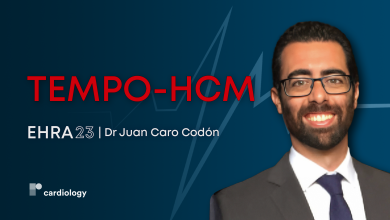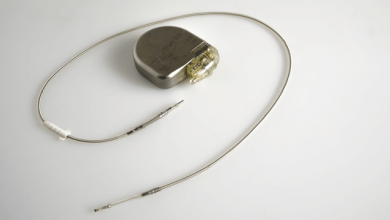Search results
Author(s):
Moinuddin Choudhury
,
Mark R Boyett
,
Gwilym M Morris
Added:
3 years ago
The sinoatrial or sinus node (SAN) is the heart’s natural pacemaker. Located in the superior right atrium, it automatically produces cyclical electrical activity to initiate each heartbeat in normal sinus rhythm. SAN dysfunction (SND) in humans, also known as ‘sick sinus syndrome’, can manifest as pathological bradycardia and asystolic pauses. As a result, SND can lead to symptoms of reduced…
View more
Author(s):
George D Katritsis
,
Demosthenes G Katritsis
Added:
3 years ago
Author(s):
Juan Caro Codón
Added:
1 year ago
EHRA 2023 — Dr Juan Caro Codón (La Paz University Hospital, Madrid, ES) discusses the findings from the TEMPO-HCM study investigating extended ECG monitoring in hypertrophic cardiomyopathy (HCM) patients.
This was a prospective, observational, multicenter trial that included patients with a diagnosis of hypertrophic cardiomyopathy. Investigators compared the rate of clinically relevant…
View more
Author(s):
Ahmadreza Karimianpour
,
Leah John
,
Michael R Gold
Added:
2 years ago
Added:
6 years ago
Author(s):
Oholi Tovia-Brodie
,
Yoav Michowitz
,
Bernard Belhassen
Added:
3 years ago
Brugada syndrome (BrS) is a cardiac disease caused by an inherited ion channelopathy. It was first described by the Brugada brothers in 19921 and is associated with a propensity to develop ventricular fibrillation (VF). Brugada syndrome is characterised by prominent J waves appearing as an ST segment elevation in the right precordial leads. In the latest guidelines, diagnosis of BrS constitutes…
View more
Convergent AF Ablation
Author(s):
Karan Wats
,
Andy Kiser
,
Kevin Makati
,
et al
Added:
3 years ago
Article
Review of Leadless Pacing
Author(s):
Nadeev Wijesuriya
,
Felicity De Vere
,
Vishal Mehta
,
et al
Added:
1 year ago
Article
Author(s):
Alexandre Raymond-Paquin
,
Santosh K Padala
,
Kenneth A Ellenbogen
Added:
2 years ago
Author(s):
Stephen P Page
,
Mehul Dhinoja
Added:
3 years ago
Over the last 30 years, the role of catheter ablation for treating a wide range of arrhythmias has increased dramatically. The electrophysiological substrates of the more straightforward arrhythmias (such as atrio-ventricular reciprocating tachycardia and atrio-ventricular nodal re-entry tachycardia) have now been well defined and excellent long-term success rates can be achieved at minimal risk…
View more















 « First
« First